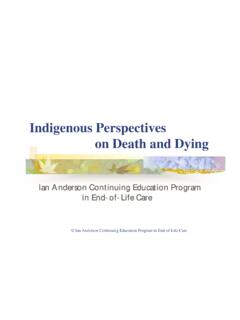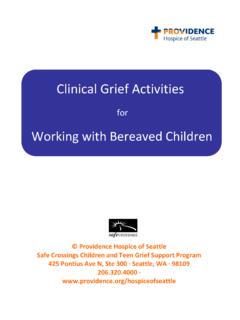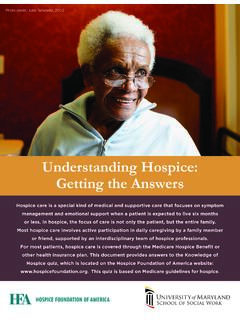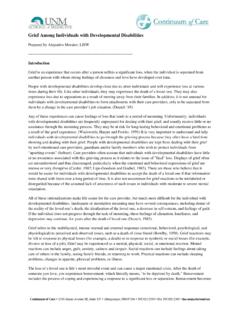Transcription of COMMUNICATION WITH PATIENTS AND FAMILIES
1 A Joint Project of Continuing Education and the Joint Centre for Bioethics, University of Toronto and The Temmy Latner Centre For Palliative Care, Mount Sinai Hospital Ian Anderson Continuing Education Program in End-of-Life Care Module 5 CCOOMMMMUUNNIICCAATTIIOONN WWIITTHH PPAATTIIEENNTTSS AANNDD FFAAMMIILLIIEESS _____ University of Toronto 2000 Ian Anderson Program in End-of-Life Care Module 5 COMMUNICATION with PATIENTS and FAMILIES 2 Author: Laura Hawryluck, MSc, MD, FRCPC Physician Leader, Ian Anderson Program, University of Toronto Assistant Professor, Critical Care Medicine, University Health Network _____ University of Toronto 2000 Ian Anderson Program in End-of-Life Care Module 5 COMMUNICATION with PATIENTS and FAMILIES 3 Case Scenario David Hawk is a 30-year-old man who presented to your office with fatigue, weight loss, night sweats, and cervical adenopathy.
2 He did not have any symptoms suggestive of infection. On physical exam, he has several 2-3 cm nodes in his anterior cervical chain that are hard but not fixed. He also has some axillary and inguinal adenopathy. You order a CBC that is unremarkable and his Monospot is negative. Concerned, you make arrangements for him to have a lymph node biopsy however you tell him not to worry, its probably nothing serious . We ll have you up and running again in no time David has always been very healthy and very active. In high school he played competitive basketball and by the time he started university, he was on the national team. He recently successfully defended his PhD thesis in biochemistry and has just been hired by a well-known pharmaceutical company.
3 He is very excited and has told you that after all his years of studying life seems to be just beginning . You have followed him regularly and outside of some minor ligamentous injuries, he has never required any medical treatment. He has two brothers both of whom are healthy. His parents are also your PATIENTS : his father has class II angina and his mother has mild asthma. You are dismayed when the biopsy of his lymph node reveals Hodgkins Disease. You bring him back to the office to tell him the bad news .. David: I can t believe this is happening. I thought you said it would not be anything serious! They have clearly made a mistake and mixed my tests results up with someone else s .. Did you think it was something serious?
4 Why didn t you tell me?? _____ University of Toronto 2000 Ian Anderson Program in End-of-Life Care Module 5 COMMUNICATION with PATIENTS and FAMILIES 4 Introduction COMMUNICATION is fundamental to the physician-patient relationship. Currently, poor COMMUNICATION is a significant problem affecting the medical profession. The Royal College of Physicians and Surgeons CanMEDS 2000 project recognizes that COMMUNICATION is essential to the provision of humane, high quality care by specialists. Unfortunately, even a quick perusal of the literature reveals that physicians lack training and knowledge in how to communicate news effectively, and deal with the emotional response to such news.
5 Even more concerning, studies show that COMMUNICATION skills do not improve and may even worsen in the course of training due to the perceived lack of value in effectively communicating on the part of more senior physicians, the lack of good role models and physical and emotional fatigue. When a person is diagnosed with a serious or life-threatening illness and is nearing the end of life, good COMMUNICATION is crucial to convey the seriousness of the illness (as difficult and sad a task as this may be), the expected course and treatment alternatives including palliative care. Only through good COMMUNICATION can pain and distress be alleviated and decisions regarding treatment and advance care planning be made.
6 Only through good COMMUNICATION can physicians convey their caring and empathy for dying PATIENTS and provide good quality end-of-life care. Objectives Describe and demonstrate the components of effective COMMUNICATION in dealing with seriously ill PATIENTS and their FAMILIES . Be able to break bad news, listen and respond to the needs (informational and emotional) of PATIENTS and their FAMILIES at the end of life. In clear language appropriate to their level of understanding, honestly address the concerns of the patient and his/her family and ensure their comprehension of any imparted information. Know and understand the consequences of the language used to impart information Be able to communicate so as to not destroy hope or provide false hope Demonstrate empathy and caring using verbal and non-verbal language Be able to communicate and discuss end-of-life decision-making in a way that is sensitive to issues of culture and religion Recognize situations in which the health care provider will have difficulty in interacting with the patient and/or family and develop COMMUNICATION skills to overcome these difficulties _____ University of Toronto 2000 Ian Anderson Program in End-of-Life Care Module 5 COMMUNICATION with PATIENTS and
7 FAMILIES 5 Effective COMMUNICATION Professional COMMUNICATION is a skill and like any skill can and must be learned. Being a nice person does not automatically mean you know how to communicate with PATIENTS and FAMILIES . COMMUNICATION is needed to establish the therapeutic relationship, obtain relevant information about problems and discuss diagnosis, prognosis and treatment options according to the patient s goals to ensure quality end-of-life care If physicians are not interactive and do not respond to the patient s needs for either information or emotional support, they will not be seen as caring and, their PATIENTS will not confide in them their hopes, dreams and fears. Without trust, good quality of care cannot be provided since PATIENTS will not tell health care providers about any pain or distress they are experiencing, what they are worried about in the future and what is important to them.
8 At the end of life, when trust is lacking, decision-making may fail to take into consideration the dying person s goals, beliefs and values and he/she may not receive treatment he/she wants or may undergo unwanted interventions Goals of COMMUNICATION at the End of Life 1. Convey respect and understanding for the patient as a person first, patient second 2. Convey information about illness, its likely course and treatment options (including resuscitation, life support and artificial nutrition)* 3. Communicate empathy and support 4. Convey appropriate hope** 5. Develop a treatment plan in context of patient s goals, values and notions of quality of life 6. Arrange for follow up meetings and reassure about ongoing care and support _____ University of Toronto 2000 Ian Anderson Program in End-of-Life Care Module 5 COMMUNICATION with PATIENTS and FAMILIES 6 * Seek to reduce unnecessary uncertainty and help with end-of-life decision-making (see End-of-Life Decision-Making Module) **Not hope for cure but hope for good quality of remaining life and/or fulfilling realistic goals and expectations Barriers to Effective COMMUNICATION Although key to the physician-patient relationship, many barriers to effective COMMUNICATION exist.
9 Due to the emotional content of COMMUNICATION , these barriers are more likely to arise when the news is bad or when the patient is at the end of life. In their efforts to improve COMMUNICATION skills, consideration of these barriers may help all health care providers to discover problems that they can work to overcome. Barriers can be divided into those due to PATIENTS and FAMILIES , due to health care providers and those due to circumstances. Barriers due to PATIENTS and FAMILIES Misunderstanding of illness, treatment options and prognosis Biases over the role of palliative care in society and medical profession Lack of knowledge of social, cultural norms, roles and expectations regarding death Re-alignment of roles within the family structure Lack support, lack of coping mechanisms crisis Physical and emotional depletion Strong emotions Differences in values.
10 Beliefs or culture _____ University of Toronto 2000 Ian Anderson Program in End-of-Life Care Module 5 COMMUNICATION with PATIENTS and FAMILIES 7 PATIENTS and FAMILIES may misunderstand the illness and the prognosis. These misunderstandings are more common when the news is bad and, when PATIENTS and FAMILIES are physically, emotionally or psychologically stressed. Physicians should give information in small chunks, and check understanding. Even if PATIENTS and FAMILIES seem to understand the news, physicians must be prepared to give repeated explanations and answer questions. Biases over the role of palliative care within society and the medical profession may lead PATIENTS and FAMILIES to misunderstand what palliative care involves.









